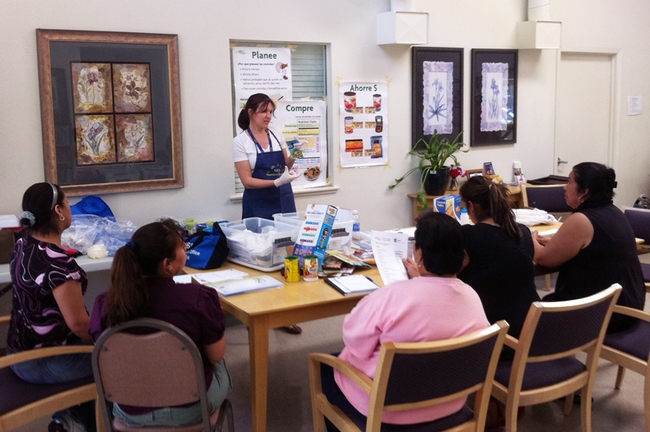
Typically, participants are offered an eight-session course called “Eating Smart Being Active.” The UC advisors realized the audience couldn’t always devote that much time to nutrition education, said Marisa Neelon, nutrition, family and consumer sciences advisor in Contra Costa County. The salient parts were extracted and compiled into four content-packed interactive lessons: Plan, Shop, Save and Cook.
Plan, Shop, Save and Cook is presented by UC CalFresh nutrition educators at schools, churches, shelters and other venues where at least 50 percent of the participants are eligible based on federal income guidelines. But anyone can benefit from the straight-forward, simple guidelines set forth in the curriculum. Below is a sampling:
Plan
Planning meals ahead saves time and money. Families save time by avoiding last-minute trips to the grocery store. They save money by taking advantage of the weekly specials and coupons that are published in the store circulars.
Before sitting down to plan a week of meals, check the refrigerator, freezer, cupboards and pantry for foods to use. Review the store’s weekly ad for foods you need and to see what vegetables and fruits are in season. In-season produce usually costs less and tastes better.
Build your meals around low-cost, healthful food items, such as:
- Protein - beans (garbanzo, black, cannellini), tofu, nuts, chicken and eggs
- Vegetables - carrots, potatoes, lettuce and leafy greens
- Fruit - apples, bananas , oranges and grapes
- Grains - brown rice, whole wheat bread, oatmeal and pasta
- Dairy - calcium fortified soy milk, milk, reduced or low fat cheese
Using the meal plan and grocery store ad, make a detailed shopping list.

At the grocery store spend time carefully reading food labels, especially the “nutrition facts” and “ingredients.”
Consider the serving size on the label, how many calories and fat are in one “serving” of food and whether that serving would be a typical portion for you and your family.
The ingredient list is also important. The ingredients are listed in descending order of predominance by weight. In other words, the ingredient that weighs the most is first, and the ingredient that weighs the least is last.
Save
When comparing prices, look for the unit price on the shelf sticker. The unit price, typically found next to the price of the product, gives the item’s cost per pound, gallon, ounce, etc. You will be able to see whether purchasing a large quantity really does cost less.
Stick to your shopping list, but be flexible. Stores will often have unadvertised specials that you can work into your healthy menu. However, avoid buying “extras” like chips and soft drinks. The cost adds up fast.
If possible, shop without children. Children may ask their parents to buy things that are not on the grocery list, not particularly healthy and often expensive. Children can also be distracting when trying to make calculations and keeping track of purchases.
If you must bring the kids, allow for extra time and involve them in the shopping process. Young children can count produce and put it into a bag. Older children can help search for specific foods, read labels and calculate unit pricing.
Cook
Use the food you purchased and the menu you planned to put together low-cost, healthy meals, such as:
- Rice and beans
- Baked chicken, potatoes and a vegetable
- Pasta and a salad
- Scrambled eggs with vegetables and toast
If your evenings are busy, keep a collection of quick recipes with minimal ingredients, find a time when you can cook several meals in advance or cook extra and plan to use leftovers for another meal.
To request a presentation of Plan, Shop, Save and Cook by UC CalFresh to an eligible group, contact your county UC Cooperative Extension office.
Attached Images:

A UC CalFresh nutrition educator presents the Plan, Shop, Save and Cook curriculum.